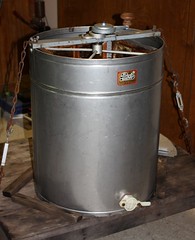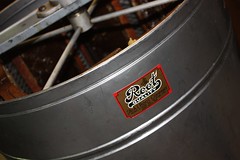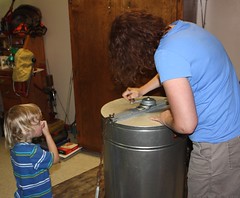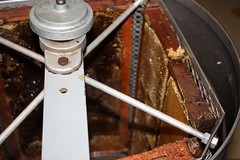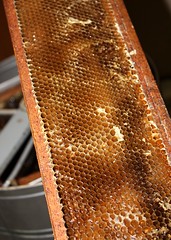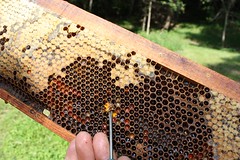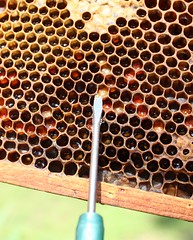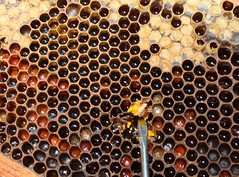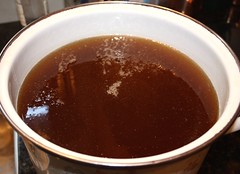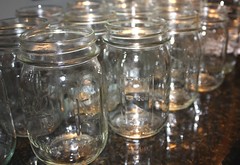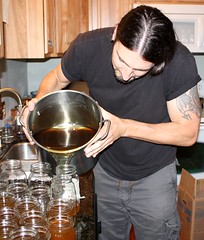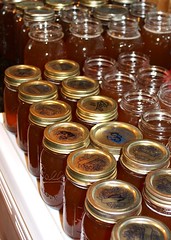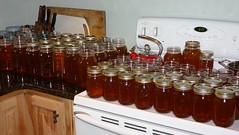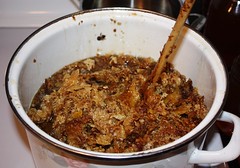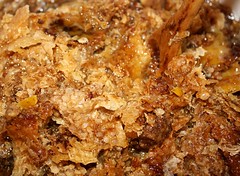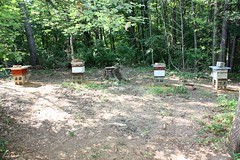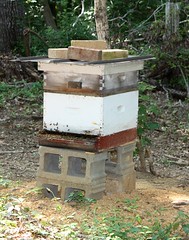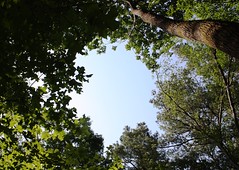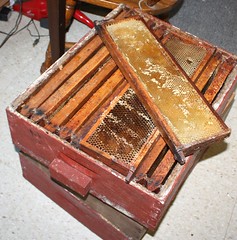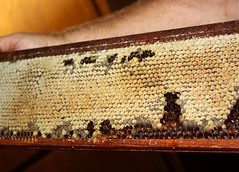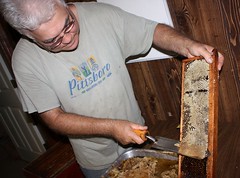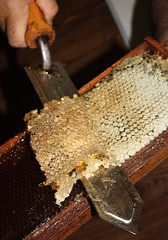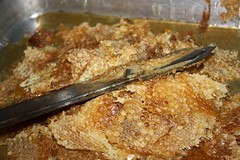spinning the honey
once the wax caps have been cut away so that the honey is exposed in the honeycomb, you load 8 frames into an extractor and spin the honey out. the extractor is basically a centrifuge, and i have learned that there are two kinds, radial and tangential. the one here is tangential, which means that we have to spin the frames twice: there is a solid layer of wax in the center of each frame, so you have spin in one direction, then flip the frames over and spin the honey out the other way as well. with a radial extractor, you can extract both sides at once because of the way the frames are positioned in the centrifuge. in both cases, as you spin the extractor, honey is forced to the outside of the cylinder and then runs down to the bottom, where it collects until you are ready to drain it. this is harder than it looks, just from a control standpoint. note that in the pictures, you can see that dan chained the whole thing down to a heavy wooden stand so that nothing could get too out of control. each of the frames isn't all that heavy on its own, but you add 8 of them, full and dripping, and your load not without some inertial mass. you have to lean down on the top of the apparatus as you crank it, or it will go flying out of your hands. and then slowing it down when you want it to stop is an act of brute strength--i am pretty sure i came a hairs breadth of letting that thing fly across the room at one point. it's worth mentioning that you can also go too slowly or too quickly as well. you want to go fast enough to extract the honey without getting TOO fast and accidentally collapsing the honeycomb in the frame. kieran and finn were fascinated by the extractor. it's loud and whirring, and produces a lot of wind if you open the lid during the spinning process. and believe me, when the bottom of the tank starts to fill up, you KNOW when it's time to stop--the thick honey will hit the bottom of the centrifuge itself, and it's suddenly like trying to stir a brick. when the honey is out of the frames, they are light, and the comb cells are empty. some people will cut the comb and include it in jars of honey, but i really don't see the point of that. unless you have a use for the beeswax, i'd say just let the bees have it back.bee pollen (aka, problem frames)
once in a while, you come across a frame that's a big pain in the butt to deal with. this one has a mix of half-filled cells, capped honey cells, and bee pollen. the pollen is the real issue--you don't want to spin that pollen out into your honey because you will NEVER get it back out again. dan taught me how to look at the frame and tell which cells are good and which are not. i thought it was odd that the bees cap the pollen cells just like the honey cells. so the trick becomes uncapping the honey cells without opening the pollen cells. then you can spin the frame just like the others to get what honey there is without getting pollen into the mix. it should also be noted that this is the bee pollen you can buy as a dietary supplement--some people believe that it's beneficial for all kinds of things ranging from improving memory, helping with weight loss, increasing sexual performance, to preventing hay fever. there's actually some evidence to support the use of local pollens to help with allergies, although from what i have read, ingesting them can also CAUSE sever allergic reactions in some people. i think most of these claims are probably marketing hokum, but what do i know, right? if i ever decide i need any, i clearly have a good source for it right here. :)straining and pouring
as you extract the honey, you periodically have to empty the tank. since we had many hands, we just ran the honey through a fine mesh strainer into big stock pots, then took it upstairs to pour into clean jars. this process is slow, but not difficult. if we were doing this as a commercial operation, we would probably have gone through more than one straining of the honey to make sure we got all of the impurities out. however, since our honey is for--well--us, we strained it once and called it good. i would say about 99% of all the stuff was out after that first straining anyway. it's actually pretty amazing how clean and clear it is straight out of the hive. after the straining, the pot of (freakin' heavy!) honey is carried up to where the jars await. these are just basic mason jars, for which i have some kind of i-was-a-farm-wife-in-a-previous-life kind of love. why do i think they are so pretty?! the pouring is straightforward, if a tad messy. i am honestly not strong enough to do it with a full stockpot of honey, so i enlisted help from the hippie. check out those guns. heh. i thought it was cute how he tucked in his hair to keep it from getting into the honey. this strategy, while seemingly sound, did NOT keep the honey from getting into the hair by the end of the day.a LOT of honey!
in the end, we harvested over 12 gallons of honey, which is a TON if you ask me! keep in mind that this is only a portion of the harvest, and only from two of the four hives. we will harvest again in the fall, but at that point, we will not take as much from each hive since winter will be coming, and the bees will need honey for themselves. i am really interested to see how the summer harvest is different from the spring one. even this time, there was a marked difference between the early spring honey, which was very light and clear, and the later honey--you could tell that dan and denise's neighbors had put in a buckwheat field in the late spring because the honey suddenly became much darker. we didn't try to separate the honey, but rather chose to blend it all together. however, i've talked to people who do this professionally, and they will rent little plots of land on which ti place bees on farms where specific crops are growing just to get different varieties of honey. i had some cotton honey once that was almost clear and so sweet it hurt my teeth, and then i've had buckwheat honey that's as dark as molasses and has a nuttier flavor. the honey is as different as the crops themselves.finishing up
last, but not least, you have to harvest the capping wax and honey. this is done with heat--you collect it all in a pot, and slowly heat it till the beeswax melts. this causes the wax to come to the top, with the dirt, debris, and impurities in a layer under the wax, and then the honey on the bottom. from this amount of wax, dan said we should get another gallon or so of honey. and this honey, we WILL keep separate since it's been heated, which changes its character.to wrap up, here are the answers to the questions everyone has been asking me since harvest day:
1. no, raw honey hasn't been heated in any way at all. it will crystallize more quickly than honey that's been heated, and if this happens, you can return it to nearly its original state by heating it very slightly. however, you don't want it to go over about 120 - 130 degrees F or you will start breaking down the sugars.after all this, i guess it's safe to say that i am even more of a honey evangelist than i used to be. it just has to be one of the coolest processes in nature. i'm grateful to dan for teaching me so much about it, and i am really hoping he will let me help with the bees in the fall when we get ready to harvest again. if so, there may be a part three. we'll see!
2. no you do NOT need or want to store honey in the fridge. it really doesn't go bad that i've ever seen or heard of. just keep it in your pantry. (or if you're like me, put it in something pretty because you are going to keep getting it out and leaving it on the counter so you can look at it.)
3. do NOT give honey to a baby under a year old. the sugars in honey are more complex than their little digestive systems can handle, and giving it to them can make them very sick. in fact, my grandmother used to say not to give it to a baby under 3 years old--the american academy of pediatrics now says one.
